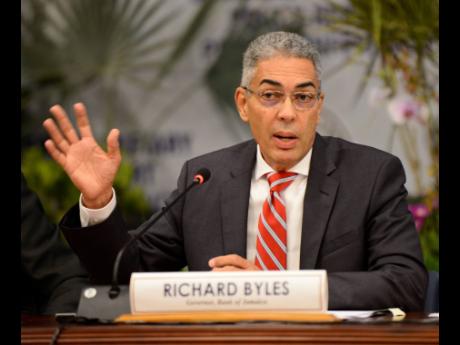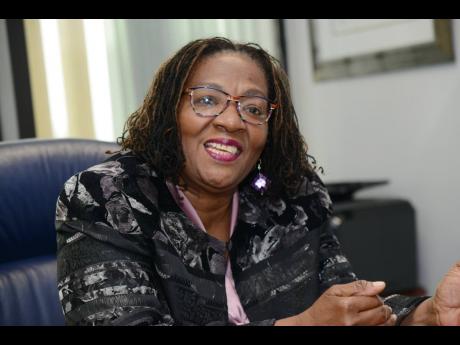No fear of bank failure, says BOJ
The central bank has painted a picture of the financial system as being more than adequately capitalised to deal with any shocks from rising interest rates, with robust monitoring of the banks’ loan books. It is downplaying fears in some quarters...
The central bank has painted a picture of the financial system as being more than adequately capitalised to deal with any shocks from rising interest rates, with robust monitoring of the banks’ loan books.
It is downplaying fears in some quarters that rates, being pushed up by the Bank of Jamaica’s, BOJ, combined 350 basis point increase in its benchmark rate since September, could result in more bad debt, business closures and a run on the financial system.
Meanwhile, the BOJ says it is boosting its capacity to monitor existing deposit-taking institutions, DTIs, protect against cyberattacks, while preparing the groundwork for the possible licensing and supervision of entirely digital banking outfits, also called neobanks.
Central bank Governor Richard Byles said this week that it would take a much higher level of interest rate, well above the current 4.0 per cent, for the monetary policy to have adverse consequences that could lead to any systemic impairment of the banking system.
“Without naming a number, I would say a pretty high interest rate, because we have run scenarios within DTIs that look at varying rates of interest and what the impact is on them, and until you get very high, into double-digit numbers, all of the DTIs remain strong and robust,” the BOJ governor responded to Financial Gleaner queries during the central bank’s monetary policy media briefing on Monday.
He did not disclose a precise threshold, but his comments confirm the bank’s repeated hints that rates could go much higher if conditions call for further increases.
Several central bank officials are trumpeting the capital adequacy of banking institutions. In figures published by the BOJ this week, commercial banks held capital of $248 billion and total assets of more than $2.1 trillion, with total liabilities being $1.8 trillion.
“The capital that they have is substantial, and that capital has been built up over the years. Remember, in the mid-1990s when we had the financial crisis, there was a big effort to get bank capital to be stronger, to be more liquid, and that has served us well during the last two years of the pandemic,” said Byes.
“I think, for the banks, the last two years have been challenging and they have come through it. I don’t expect that the next two years will be as challenging but, in any event, all of our tests show that they remain strong and robust even with pretty high interest rates,” he said.
BOJ Senior Deputy Governor Dr Wayne Robinson added that Jamaica’s banks have built up resilience to deal with different shocks, including deterioration in the quality of their loan pools.
“The banks have also been ensuring that they have adequate provisions to account for any further deterioration in the quality of the loans. So we think that the banks are in a position to absorb further adjustments and further economic shocks,” Robinson said, in response to the Financial Gleaner at the briefing.
The central bank reported that non-performing loans, or bad debt, have now risen to 3.2 per cent of the total loan portfolio, from last year’s 3.0 per cent, but that the figure is well within acceptable limits.
Up to December 2021, commercial banks had combined loans of $980 billion, with the largest of them, National Commercial Bank Jamaica, reporting a loan book of more than $400 billion, and its closest rival, Scotiabank, $177 billion. The country’s two building societies have $183.5 billion in loans, while the lone merchant bank, Cornerstone Trust and Merchant Bank, reported a loan portfolio of $3.25 billion.
BOJ Deputy Governor Maurene Simms, who heads the central bank’s financial institution supervisory division, says the central bank is satisfied with its data capture and has its fingers on the pulse of bank credit.
“Ever since the pandemic, we increased our monitoring of banks’ portfolios tremendously. In the context that loans and advances is the largest asset class on banks’ books, we follow this very closely. NPL is just about 3.2 per cent, compared to three per cent last year – well below five per cent, where we start to get concerned, and below the 10 per cent, where we are really concerned about the quality of loans,” Simms said.
Stress tests, she added, are used to detect any shift in trends and prompts pre-emptive action by the central bank.
According to BOJ’s most recent Macroprudential Report released in February, the stress tests, from a range of shocks to the banks’ balance sheets, showed that their “susceptibility to interest rate shocks improved, largely due to strengthened capital positions,” while for securities dealers, that sector “was generally resilient to foreign exchange and liquidity risk shocks,” the report said.
There was an uptick in bank leverage due to an increase in the use of debt to fund operations and expansion, but the report noted it was not a cause for concern.
Jamaica’s leverage at 6 per cent is twice the international standard.
“The international standards are between three and four per cent for the leverage ratio. In Jamaica’s case, the capital that DTIs own is core capital – the most loss-absorbing capital and best capital that can be had,” said Simms.
“That capital is funding over 10 per cent of their balance sheet, compared to a minimum of six per cent. So, they do have capacity to take on more leverage, and they are much less leveraged than their international or regional counterparts,” she said.


